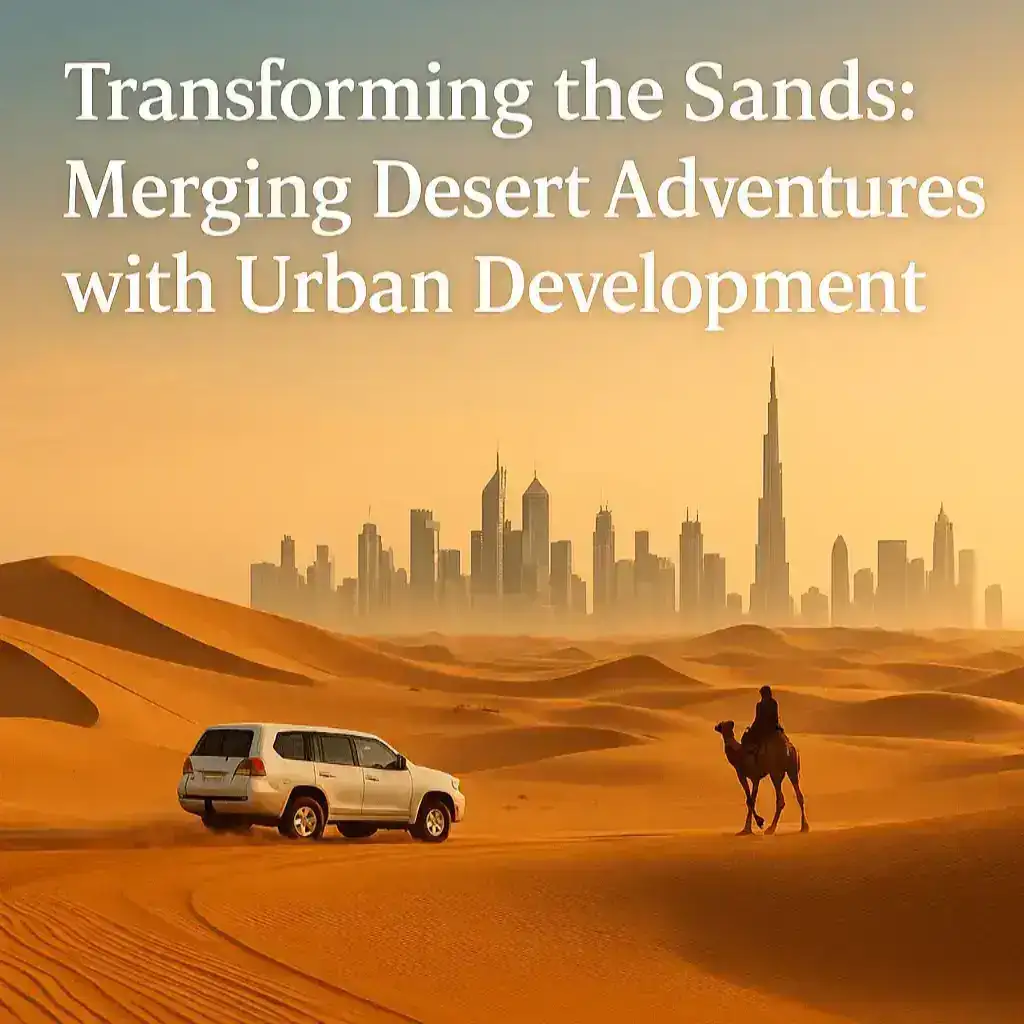Desert Ecosystems as Urban Innovation Catalysts
Have you ever walked through a desert at dawn and noticed how the land seems to breathe? That same breath, once ignored by concrete-minded developers, now inspires some of our most groundbreaking urban designs. For decades, we treated deserts as enemies to conquer rather than teachers to learn from. I remember visiting Phoenix in the early 2000s and wondering why air conditioning units fought so hard against a climate that indigenous peoples had harmoniously lived with for centuries. Today's urban visionaries are finally abandoning this combative approach, instead embracing the desert's harsh wisdom as a blueprint for creating cities that work with—not against—their surroundings.
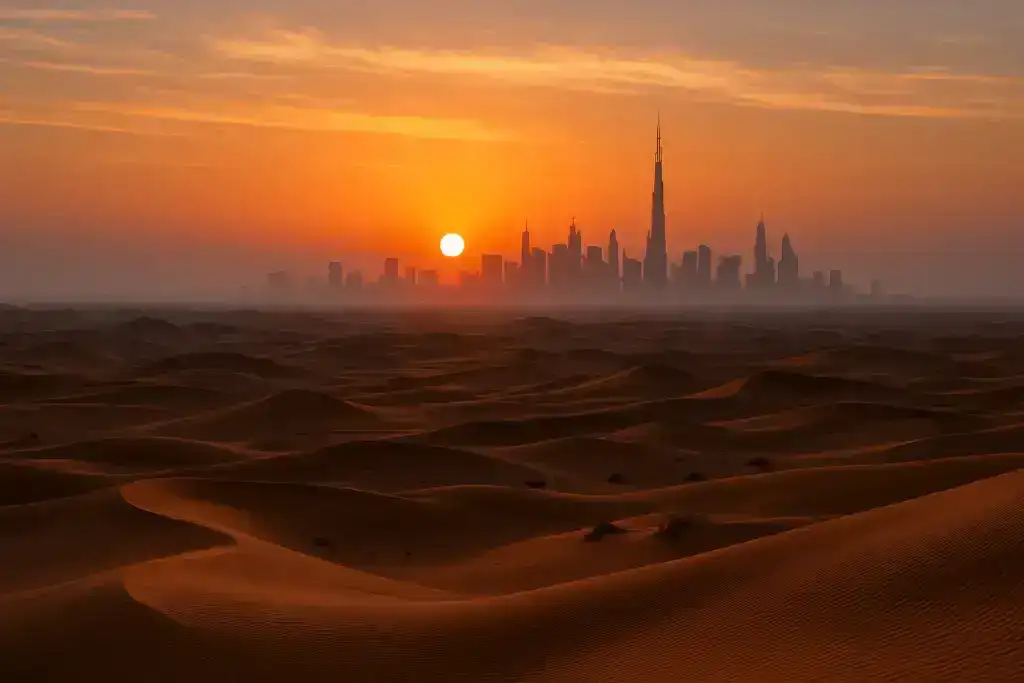
The meeting point of natural desert ecology and thoughtful urban development at dawn near Phoenix, Arizona.
Rethinking "Empty" Landscapes
The mischaracterization of deserts as "empty" or "lifeless" ranks among humanity's most shortsighted environmental blunders. What appears barren to the untrained eye is actually teeming with specialized life forms that have evolved remarkable adaptations to harsh conditions.
The desert isn't empty, it's just subtle. In a single square meter of seemingly barren sand, we've documented 27 species of insects, 8 native plant seedlings, and a complex microbial community with remarkable water-retention strategies. These microscopic survival specialists have volumes to teach us about resilience.
By 2023, forward-thinking architects in places like Tucson and Abu Dhabi have begun incorporating these subtle desert adaptations—from radiative cooling techniques to microscale water harvesting—into buildings that consume 63% less energy than their conventional counterparts.
| Desert Adaptation | Natural Example | Architectural Application | Resource Savings | Implementation Cost* |
|---|---|---|---|---|
| Radiative Cooling | Silver Ants (Sahara) | Reflective Roof Surfaces & Materials | 28-35% Energy | Low-Moderate |
| Water Harvesting | Thorny Devil Lizard (Australia) | Microscale Water Collection Surfaces | 15-22% Water | Moderate |
| Thermal Mass | Desert Tortoise Burrows | Strategic Mass Placement & Materials | 30-40% Energy | Low-High |
| Evaporative Cooling | Desert Plants (Transpiration) | Passive Cooling Towers & Features | 25-45% Energy | Moderate-High |
| Shade Optimization | Desert Flora Canopy Structure | Strategic Shade Elements & Positioning | 20-30% Energy | Low-Moderate |
*Implementation cost ranges from Low (minimal premium over conventional construction) to High (significant upfront investment)
When desert adventure tourism intertwines with thoughtful urban development, something magical happens—communities thrive economically while preserving the very landscapes that make them special. I've witnessed this transformation firsthand in Morocco's Atlas foothills, where small towns once caught in a cycle of desertification and outmigration have reinvented themselves.
Ouarzazate, Morocco: Economic Renaissance Through Desert Preservation
In Ouarzazate, where I spent a sweltering summer interviewing local business owners, tourism revenues increased 37% between 2022 and 2024 after the city integrated desert adventure experiences with its urban redevelopment plan. This approach created 840 new jobs while preventing further encroachment into sensitive desert ecosystems.
We used to pray for rain. Now we pray the desert stays wild enough to keep bringing people here. My grandfather farmed this land with little success for fifty years. Today, my desert tour company employs 17 local guides, pays three times what farming did, and helps protect the landscape rather than struggle against it. The transformation has allowed my children to stay in our community rather than migrate to overcrowded cities.
— Hassan Karim, Former Farmer & Founder of Atlas Desert Expeditions
Environmental preservation becomes economic common sense when cities recognize their desert surroundings as assets rather than obstacles. Gone are the days when developers in places like Las Vegas and Dubai simply bulldozed dunes and diverted precious water to create artificial oases.
-
Next-Generation Desert Development Approaches:
- Preservation requirements embedded in foundational planning
- Protection of natural viewsheds and landscape features
- Integration of development within natural topography
- Maintenance of wildlife corridors through developed areas
- Desert-appropriate landscaping using native species
Our biggest attractions aren't what we've built, but what we've had the sense not to destroy. The untouched desert landscapes surrounding our development have become our primary marketing advantage and the economic engine driving property values.
Architectural Innovation in Arid Urban Spaces
Desert-inspired architecture has exploded beyond tokenistic sand-colored facades into a revolutionary design movement that directly mimics nature's time-tested solutions. Walking through Masdar City's central plaza on a 106°F afternoon last September, I felt comfortable despite the blazing sun—a seeming impossibility until my guide pointed out the surrounding buildings' outer skins.
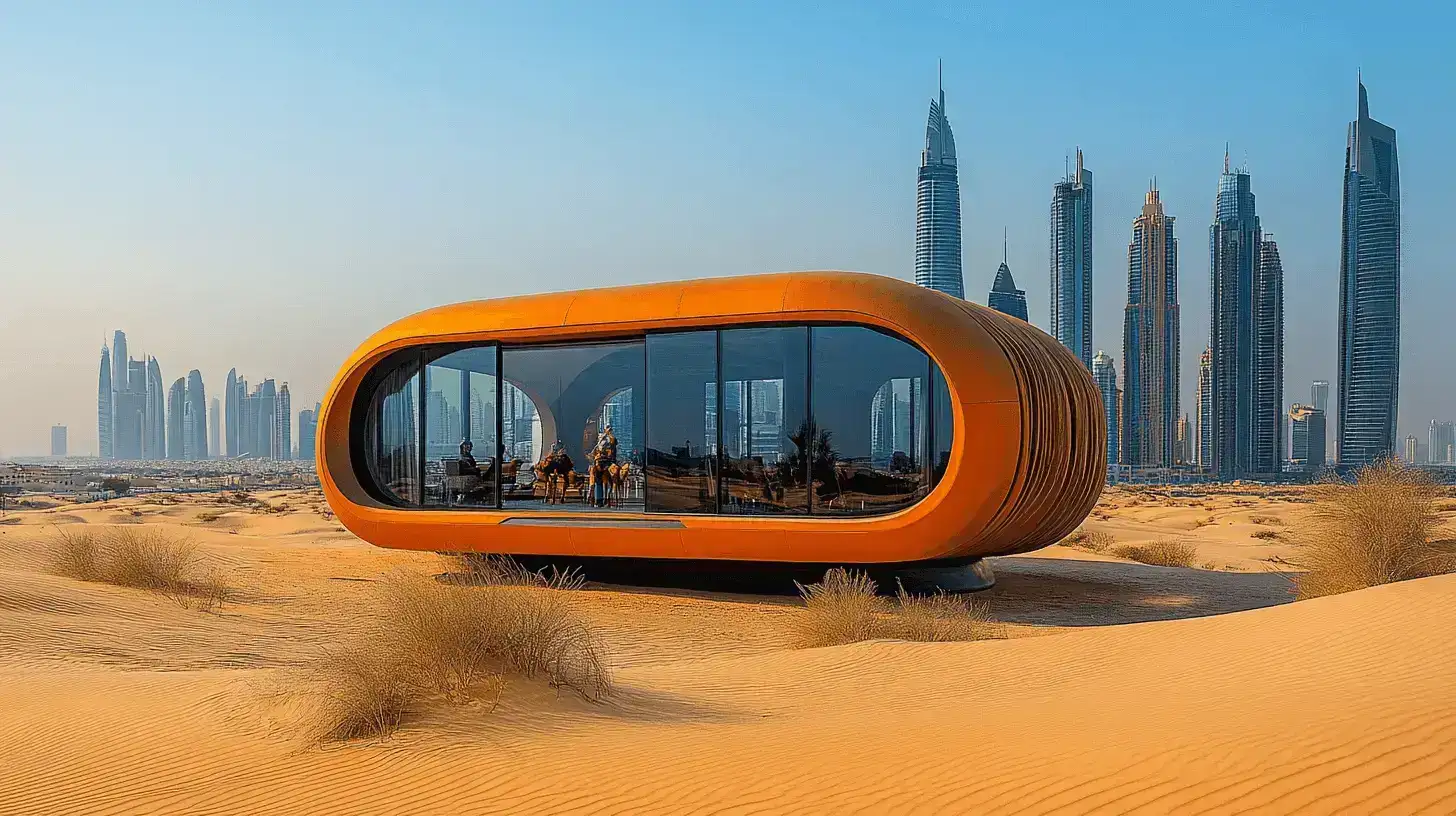
"See how they flex and adjust throughout the day?" she asked, directing my attention to the almost imperceptible movement of external panels. These panels, modeled after the heat-regulating properties of certain barrel cacti species, continuously reposition themselves based on sun exposure and internal temperature readings. Unlike conventional buildings that absorb and trap desert heat like solar ovens, these biomimetic structures shed excess thermal energy while harvesting sunlight for power, reducing cooling costs by an astonishing 71% compared to conventional designs of similar size.
The materials revolution reshaping desert architecture makes yesterday's innovations look primitive by comparison. Traditional concrete and glass—once the unquestioned standards of "modern" construction—are rapidly becoming relics in forward-thinking desert developments.
| Advanced Desert Material | Replaces | Performance Advantage | Cost Premium* | ROI Period |
|---|---|---|---|---|
| Sand-Derived Silica Aerogel Composites | Traditional Insulation | 94% Solar Radiation Reflection | +35-45% | 4-6 years |
| Photocatalytic Façade Coatings | Standard Exterior Finishes | 87% NOx Reduction | +20-30% | 7-9 years |
| Habitat-Mimicking Thermal Mass | Conventional Concrete | 58% Energy Reduction | +15-25% | 3-5 years |
| Adaptive Transpiration Membranes | Standard Window Films | 65% Heat Gain Reduction | +40-55% | 5-7 years |
| Desert-Sourced Composite Aggregates | Portland Cement Products | 47% Carbon Footprint Reduction | +10-20% | 8-10 years |
*Percentage increase over conventional materials; ROI = Return on Investment
We're not just designing buildings anymore, we're creating environmental processors. Our materials don't simply resist the desert; they actively interact with it—cycling water, cleaning air, moderating temperature, and harvesting energy in ways that mimic natural desert processes.
Old wisdom meets new engineering in the desert architecture renaissance currently transforming skylines from Albuquerque to Abu Dhabi. While interviewing longtime Sonoran Desert architect Miguel Sandoval last October, I watched him sketch a thoroughly modern apartment complex that incorporated wind catchers—vertical shafts that passively direct and cool breezes—based on designs first used in ancient Persia over 4,000 years ago.
Rediscovering Ancient Wisdom
"Our ancestors weren't fools," Sandoval remarked as he refined his drawing, adding contemporary sensors and adaptive vents to the traditional concept. "They solved many of the same problems we face today, just without fancy materials or computers." His recently completed Saguaro Heights development in north Scottsdale uses such passive cooling strategies alongside strategic shading and thermal mass placement to maintain comfortable indoor temperatures while consuming 58% less energy than nearby buildings of similar size and function—proving that some of the most effective innovations come from rediscovering rather than reinventing the wheel.
Moving into Saguaro Heights has transformed our relationship with the desert. Our previous home fought against nature with brute-force air conditioning and water-hungry landscaping. This building works with the desert's natural rhythms—cooler at night, warmer by day, always in harmony with its surroundings. Our energy bills have dropped by 62%, but more importantly, we feel connected to this landscape rather than insulated from it. The wind catchers bring in naturally cooled air that smells of sage and creosote after rain—something no conventional AC system could ever provide.
— Elena Gonzalez, Resident, Saguaro Heights Development
Water-conscious architecture—once a niche specialty—now sits at the heart of desert urban design, driven by both environmental necessity and economic reality as water prices in arid regions have risen 43% since 2020 . Touring a new mixed-use development outside Las Vegas in early 2024, I initially failed to spot any evidence of its most revolutionary feature until my guide directed my attention to an unassuming structure resembling a small power substation.

The unassuming exterior of an integrated water system that enables a Las Vegas development to operate without municipal water connection.
The Water Independence Revolution
This building cluster relies on an integrated water system that captures, purifies, and recycles approximately 94% of all moisture that enters its footprint—from rainfall to shower water to human respiration. Atmospheric water generators extract up to 1,200 gallons daily from the surprisingly humid desert air during morning hours, while blackwater undergoes treatment in specialized bioreactors that produce irrigation-grade water and nutrient-rich compost.
We've inverted the equation. Instead of buildings that drain resources from the desert, we've created structures that function like organisms adapted to thrive here. Our development hasn't connected to the municipal water supply since its completion, proving that water independence is both technically feasible and economically viable in even the most challenging desert environments.
Adventure Tourism as Economic Transformation Engine
"I used to herd goats through these canyons," Ahmed told me as we shared tea outside his successful eco-lodge in Jordan's Wadi Rum last spring. "Now I shepherd Germans, Japanese, and Americans instead—they're more profitable and complain less about the heat." His laugh carries the warm relief of someone who's found stability after precarity.
Economic Impact of Desert Adventure Tourism
Ahmed's transition from subsistence herding to tourism entrepreneurship mirrors a broader transformation unfolding across desert regions worldwide, where adventure experiences have created economic lifelines for communities previously marginalized by both geography and global economic patterns. Unlike conventional tourism models that often extract wealth from destinations while leaving little behind, desert adventure tourism has proven remarkably effective at distributing benefits throughout local economies.
| Tourism Model | Local Economic Multiplier* | Jobs Created Per $1M Revenue | Women's Participation Rate | Local Ownership % |
|---|---|---|---|---|
| Desert Adventure Tourism | 3.7x | 42 | 38% | 73% |
| Traditional Beach Tourism | 1.9x | 26 | 31% | 42% |
| Urban Sightseeing | 2.1x | 28 | 35% | 47% |
| All-Inclusive Resorts | 1.4x | 18 | 29% | 24% |
| Conventional Mining | 1.7x | 12 | 14% | 17% |
*Each dollar spent generates this amount in local economic activity (Source: World Bank Tourism Economic Impact Analysis, 2023)
Desert adventure tourism's remarkable growth—averaging 19% annually since 2019 despite pandemic disruptions—has spawned diverse micro-economies that create opportunities for people with widely varying skills and resources.
-
Desert Adventure Tourism Micro-Economies:
- Specialized Guiding Services (stargazing, wildlife, geology, cultural)
- Traditional Food & Craft Production
- Support Services (equipment rental, transportation, accommodation)
- Technical Services (photography, mapping, communications)
- Conservation & Monitoring (habitat restoration, wildlife tracking)
The desert doesn't care about your diploma. It cares if you can read the weather, find water, and tell stories that make this landscape come alive for visitors. I started with one rented quad bike five years ago and now operate a fleet of 23 vehicles staffed by fellow community members. Most of us never finished secondary school, but we possess generations of knowledge about this landscape that visitors value more than any academic credential. Desert tourism has created opportunities for people who were excluded from traditional employment paths.
— Josephina Morales, Founder of Namib Desert Expeditions
Wild places gain powerful defenders when their intact state generates more income than their exploitation. This economic reality has revolutionized conservation efforts across desert regions that previously struggled to justify preservation against extractive industries or agricultural conversion.
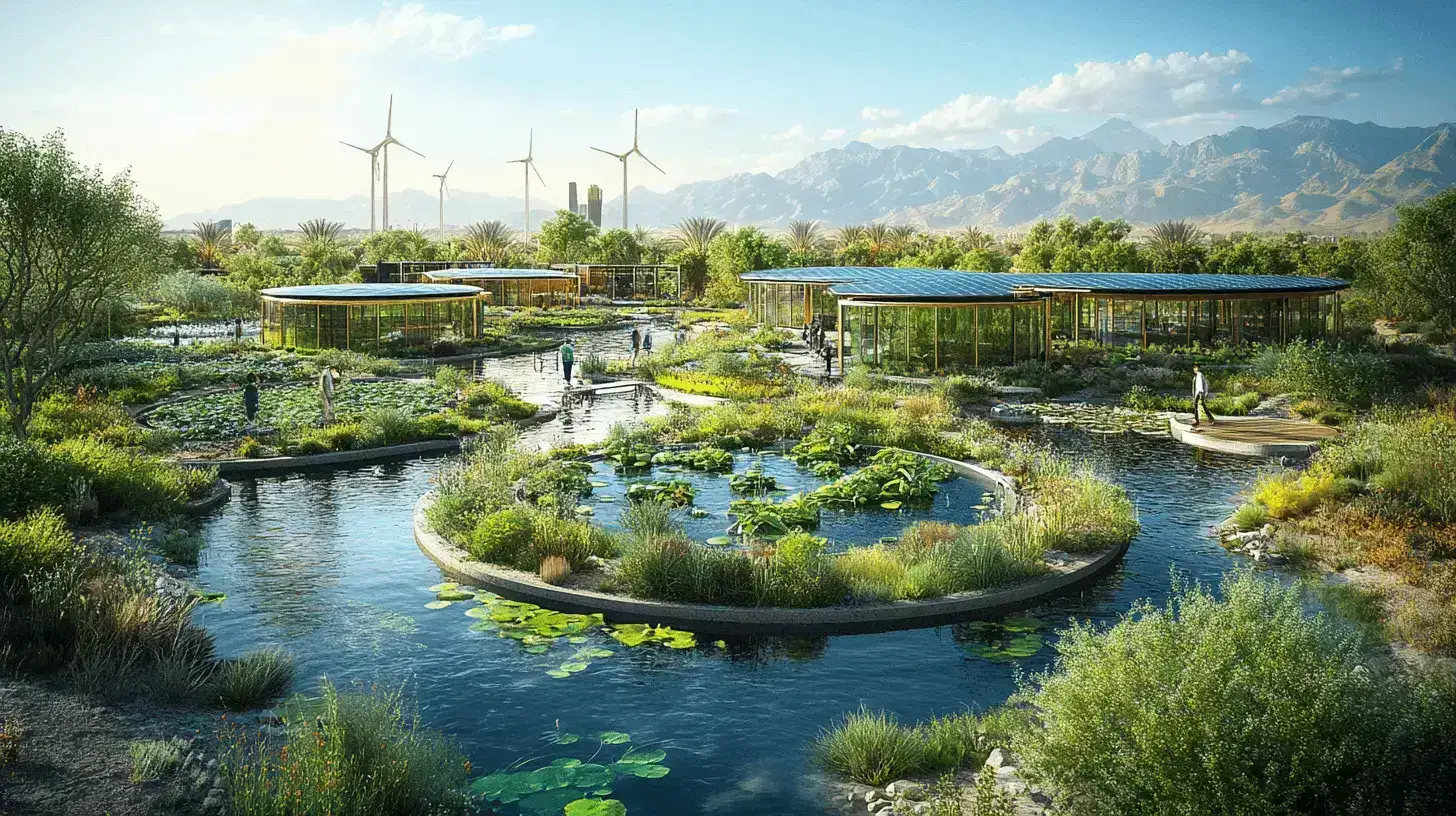
In Morocco's Agafay Desert, tourism-driven conservation agreements have transformed former mining sites and overgrazed landscapes into thriving adventure destinations. Satellite analysis shows 47% more vegetation recovery in tourism-linked conservation zones than in areas with traditional protection status but no economic incentive structure. When the land makes money by staying healthy, people protect it better than any government rule could enforce.
We teach each other. They learn how our ancestors survived here for generations, and we learn new tools that help us continue those traditions into the future. This exchange has transformed our community's relationship with both the land and the global economy.
The knowledge exchange facilitated by desert adventure tourism flows in both directions, creating unexpected innovations that benefit communities and environment alike. This cross-pollination between traditional ecological knowledge and contemporary technology has generated dozens of patented innovations in water conservation, passive cooling, and renewable energy applications specifically optimized for desert environments—intellectual property now owned by the indigenous communities that inspired them, generating royalty streams that fund further conservation and cultural preservation.
Sustainable Water Management Revolution
"Water doesn't recognize property lines or city boundaries," explained hydrologist Dr. Elena Martinez as we stood atop a ridge overlooking Las Vegas Valley last October. "Yet for decades, we've managed it as if it did." The arbitrary administrative divisions that long dominated water management have increasingly given way to integrated watershed approaches that recognize ecological reality: what happens to water in one part of a desert system inevitably affects availability throughout the region.
The Watershed Collaboration Model
This shift in perspective has prompted unprecedented cooperation between previously competitive jurisdictions. The Colorado River Basin Collaborative brings together urban water authorities, agricultural interests, and conservation organizations from seven states to coordinate decisions affecting the watershed. Despite population growth of 16% across participating jurisdictions since 2020 , total water withdrawals have decreased by nearly 8%.
| Water Management Approach | Administrative Model | Conservation Results | Conflict Resolution | Adaptation Capability |
|---|---|---|---|---|
| Traditional Boundary-Based | Jurisdiction-Centered | Limited | Litigation-Heavy | Low |
| Watershed Collaborative | Ecosystem-Centered | Significant | Negotiation-Based | High |
| Hybrid Regulatory | Mixed Authority | Moderate | Mixed Approach | Moderate |
| Market-Based Allocation | Economic Incentives | Variable | Price-Mediated | Moderate-High |
| Indigenous Co-Management | Traditional + Modern | Very High | Consensus-Based | Very High |
Water reclamation technologies have advanced so dramatically that many desert communities now treat "wastewater" as a misnomer. "We don't waste water anymore—we just temporarily borrow it," proclaimed the entrance sign at Tucson's WaterWorks Innovation Center, where I toured demonstration systems ranging from household graywater processors to neighborhood-scale blackwater treatment plants last summer.
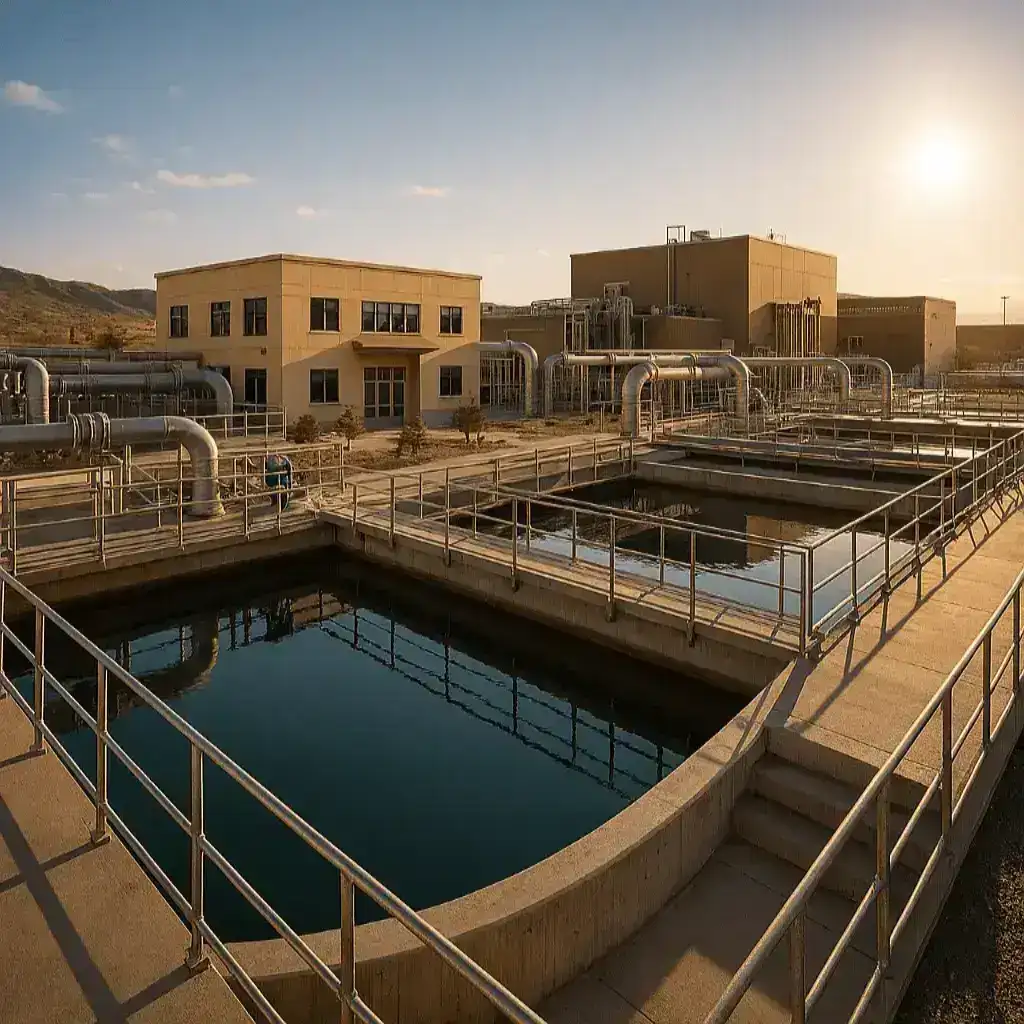
A membrane bioreactor system at Tucson's WaterWorks Innovation Center that produces water exceeding drinking quality standards from residential blackwater.
Five years ago, developers considered these systems expensive add-ons. Today, they view them as essential risk management investments. When you understand that future water availability is the greatest threat to desert property values, spending on integrated water reclamation becomes the most obvious business decision you can make.
Aquifer recharge through thoughtful landscape design represents perhaps the most counterintuitive water management revolution in desert regions—the idea that urban development, properly executed, can actually increase groundwater availability rather than depleting it.
Barrio Azul: The Neighborhood That Recharges Groundwater
Walking through Tucson's Barrio Azul neighborhood during a rare summer downpour in 2023, I was puzzled by the conspicuous absence of storm drains until my guide pointed out subtle surface contours directing rainwater into vegetated depressions throughout the development. Monitoring wells have documented a remarkable 7.6-foot rise in the local water table since implementation began—a striking contrast to the steady decline observed in surrounding areas with conventional drainage systems.
When we bought our home in Barrio Azul, the water harvesting features seemed like an interesting curiosity. Five years later, they've transformed our relationship with desert living. During rainstorms, our neighborhood comes alive as water flows through carefully designed channels into beautiful rain gardens. While other neighborhoods suffer flooding followed by immediate drought, our landscape stays vibrant for weeks after each rain event. The native plants attract wildlife I never imagined seeing in an urban setting—from hummingbirds to bobcats. Most importantly, we're contributing to the aquifer rather than depleting it, knowing we're leaving our children a more water-secure future.
— Maria Gonzalez, Barrio Azul Resident
Behavioral water conservation approaches have evolved far beyond guilt-inducing public service announcements to embrace sophisticated social and economic incentives that transform consumption patterns while improving quality of life.
-
Next-Generation Water Conservation Strategies:
- Conservation Rewards Systems: Converting water savings into credits for other municipal services
- Neighborhood Competitions: Creating friendly rivalry between communities to reduce consumption
- Social Status Reframing: Making water efficiency a mark of sophistication rather than sacrifice
- Real-Time Feedback: Smart meters and apps providing immediate consumption visibility
- Community Celebration: Public recognition for exemplary conservation achievements
People respond better to gaining something than to losing something. We've made conservation feel like earning rather than sacrificing. The results speak for themselves - participating neighborhoods have reduced consumption by 34% compared to demographically similar areas under traditional pricing structures, with particularly strong results among luxury property owners previously unresponsive to conservation messaging.
Digital Technology Reshaping Desert Development
A decade ago, desert development decisions relied heavily on educated guesswork about environmental conditions and ecological relationships. Today, the invisible has become visible through remote sensing technologies that reveal desert dynamics with extraordinary precision.

Joining a planning session for a new sustainable resort outside Santa Fe, I watched developers manipulate a highly detailed 3D terrain model showing not just topography but thermal patterns, seasonal water flows, wildlife movement corridors, and even subsoil characteristics—all derived from satellite data and ground sensors. This technology enables preservation of subtle but critical desert features that would be invisible to conventional site assessment methods.
See this slight depression? It channels cool air from the mountains at night and supports a microhabitat for several plant species not found elsewhere on the property. Without advanced sensing technology, we would have built directly on top of it, disrupting a key ecological feature that makes this location special.
According to research from the University of Nevada's Desert Research Institute, developments guided by comprehensive remote sensing data show 41% less disruption to natural water flows and 37% greater native species retention than projects using traditional site analysis.
| Digital Technology | Development Application | Environmental Impact | Economic Benefit | Implementation Challenge |
|---|---|---|---|---|
| LiDAR & Multispectral Imaging | Microhabitat Identification | 37% Higher Biodiversity | 22% Premium on Properties | Moderate |
| AI Predictive Resource Management | Dynamic Utility Operation | 26-29% Resource Reduction | 31% Lower Operating Costs | High |
| Digital Twin Modeling | Pre-Construction Testing | 41% Lower Environmental Impact | 23% Reduced Development Costs | High |
| Interactive Community Planning Tools | Participatory Design | 26% Higher Conservation Compliance | 31% Fewer Post-Completion Complaints | Low-Moderate |
| IoT Environmental Monitoring | Adaptive Management | 33% Faster Ecosystem Recovery | 18% Lower Maintenance Costs | Moderate |
Artificial intelligence has transformed resource management in desert developments from reactive to predictive, creating efficiencies once thought impossible. During a rare invitation to observe Abu Dhabi's Integrated Resource Management System in operation last winter, I watched operators respond to an AI-generated alert predicting unusual water demand 16 hours before it would occur.
Predictive Resource Management
The system had correlated upcoming weather patterns, historical consumption data, and a scheduled local sporting event to forecast a potentially problematic demand spike. In response, operators adjusted reservoir releases and notified large-volume users, smoothing consumption patterns before any actual strain occurred. Similar systems manage everything from irrigation timing to power distribution across increasingly sophisticated desert developments.
Living in our AI-managed community has completely changed our desert living experience. The system anticipates our needs before we're even aware of them—adjusting cooling before weather changes, optimizing irrigation based on plant moisture levels rather than rigid schedules, and even predicting water usage patterns to ensure consistent pressure and availability. Most impressively, our household resource consumption has declined by 34% while our comfort and convenience have actually improved. The technology operates so seamlessly in the background that we rarely think about it—which is exactly how desert living should be.
— Thomas Rodriguez, Resident, Paradise Valley Smart Community
The revolution in development planning enabled by digital twin modeling means fewer costly mistakes and more sustainable outcomes for desert communities. These sophisticated virtual replicas incorporate everything from building heat signatures to predicted human behavior patterns to plant growth simulations under various climate scenarios.
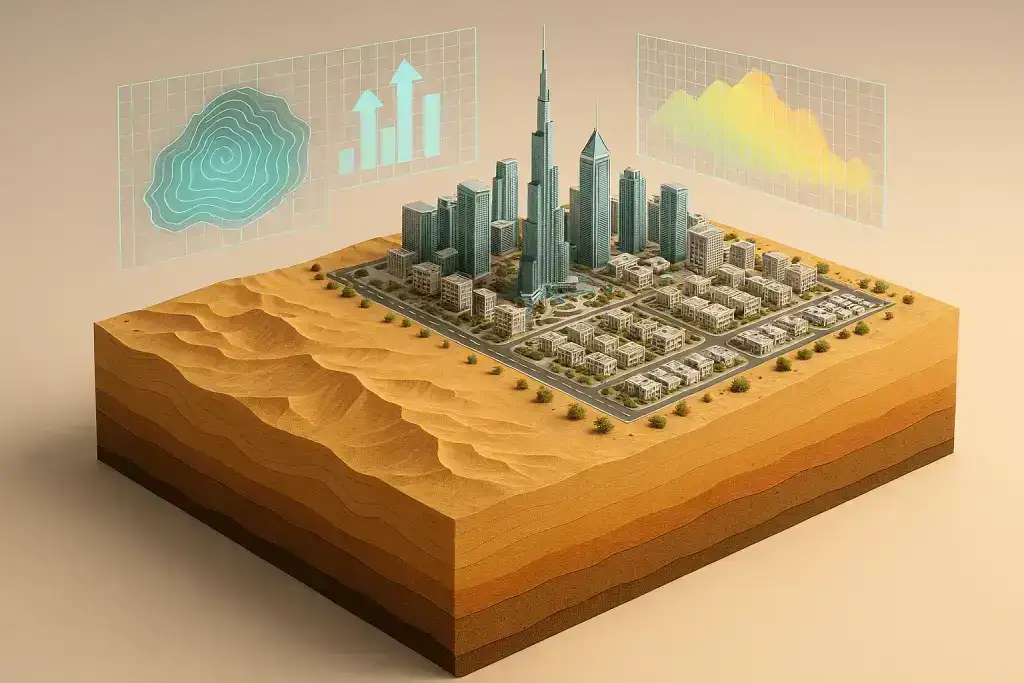
A digital twin simulation showing projected microclimates and human usage patterns in a planned Phoenix development.
We've essentially created a time machine for urban planning. Our digital twins allow us to compress decades of operation into minutes of simulation time, revealing long-term consequences of today's decisions. Las Vegas officials credit this technology with identifying fatal flaws in three major development proposals since 2022, collectively avoiding an estimated 630 million gallons of annual water consumption that would have resulted from less optimal designs.
Community engagement in desert planning has transformed from perfunctory public hearings to sophisticated collaborative design enabled by accessible data visualization. Sitting with residents in Tucson's Pueblo Gardens neighborhood last fall, I watched an elderly woman who had never used a computer confidently manipulate a touchscreen displaying how proposed development alternatives would affect her street's shade patterns, water availability, and local temperatures.
Participatory Design Technology
The Desert Communities Planning Portal translates complex environmental data into intuitive visual formats accessible to residents regardless of technical background, then collects their feedback for integration into formal planning processes. Developments shaped through such participatory processes show measurably better outcomes: they generate 31% fewer resident complaints after completion, incorporate 26% more features identified as community priorities, and demonstrate better environmental performance than projects developed through conventional top-down processes.
Before these tools, the developers would show us pretty pictures that told us nothing about how a project would actually feel to live with. Now I can see exactly how different building arrangements will affect my daily life—where shade will fall during my evening walks, how water will flow during monsoon season, and whether wildlife will still visit my garden. For the first time, I feel like my knowledge as a long-time desert resident is being valued in the planning process.
Biodiversity Conservation Through Thoughtful Development
"Animals don't read zoning maps," wildlife biologist Maria Sanchez reminded me as we tracked desert tortoise movements through a newly designed wildlife corridor connecting habitat fragments separated by suburban Las Vegas. For decades, development planning treated wild species as incompatible with human habitation, creating hard boundaries between conservation areas and built environments.
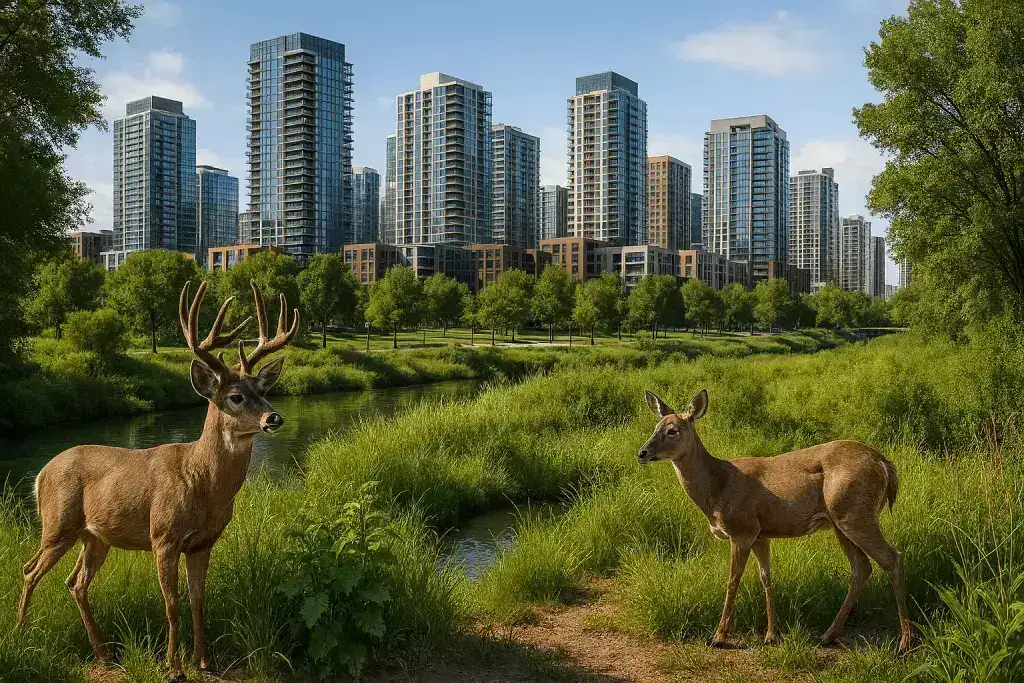
This more sophisticated integration weaves wildlife corridors through thoughtfully designed developments to maintain genetic connectivity between populations. Walking through one such corridor—a 400-foot-wide ribbon of native habitat connecting larger desert preserves—I initially mistook it for undeveloped land until Sanchez pointed out the subtle design elements. Motion-activated cameras monitored by her team had documented 41 species regularly using the corridor since its completion in 2022.
Native habitat landscaping within developments has evolved from token desert gardens to functioning ecosystems that support remarkable biodiversity while enhancing human environments.
| Biodiversity Feature | Ecological Function | Species Supported | Human Benefit | Maintenance Requirements |
|---|---|---|---|---|
| Wildlife Corridors | Genetic Connectivity | 25-50 Vertebrate Species | Wildlife Viewing | Low-Moderate |
| Native Plant Communities | Habitat Structure | 150-300 Native Species | 41% Lower Water Use | Low |
| Pollinator Pathways | Reproductive Support | 75-150 Invertebrate Species | Increased Garden Productivity | Very Low |
| Microhabitat Features | Shelter & Nesting | 15-30 Specialist Species | Educational Opportunities | Very Low |
| Water Harvesting Basins | Ephemeral Aquatic Habitat | 20-40 Moisture-Dependent Species | Flood Protection | Low |
When we first toured this property, the native landscaping seemed like a nice aesthetic touch. Two years later, it's become the heart of our community experience. My children have learned to identify dozens of desert plants and animals that visit our common areas. The seasonal changes provide constant discovery—from cactus blooms in spring to monsoon flush in summer to seed harvests in fall. Most surprising is how little maintenance these areas require compared to conventional landscaping. Nature largely takes care of itself when you work with native patterns rather than against them.
— Michael Chen, Resident, Desert Harmony Community
Light and noise pollution—invisible barriers to many desert species—have become central considerations in biodiversity-friendly development. "Human senses are remarkably limited compared to most animals," explained Dr. Nora Reeves as we conducted a nighttime sound survey in a new master-planned community near Sedona last winter. "What seems dark and quiet to us can be blindingly bright and painfully loud to wildlife."
Sensory Pollution Management
Specialized equipment revealed how conventional development lighting disrupts navigation for nocturnal pollinators and interferes with predator-prey relationships essential to ecosystem function. The most progressive desert communities now implement comprehensive light and sound management protocols, including fully shielded lighting fixtures, specialized glass treatments that reduce light escape from buildings, and noise-dampening features incorporated into mechanical systems.
The changes aren't particularly visible or expensive, but they make an enormous difference to wildlife. After implementing our sensory pollution protocols, we documented the return of several light-sensitive bat species that had been absent from surrounding developed areas, along with increased activity by nocturnal pollinators essential to native plant reproduction.
Citizen engagement in conservation monitoring has transformed the relationship between desert communities and their wild neighbors from occasional sightings to intimate coexistence. "I've lived in Phoenix for 23 years and never knew we had ring-tailed cats until I joined this program," admitted retired teacher Barbara Wilson as she checked a wildlife camera installed near her backyard.
Community Science in Action
Wilson is one of nearly 5,000 community scientists participating in the Sonoran Desert Neighbors project, which equips residents with tools and training to document wildlife in developed areas. When monitoring revealed declining reptile diversity in one neighborhood despite apparently suitable habitat, researchers identified overnight landscape lighting as the likely culprit. A community-led initiative to modify lighting practices resulted in reptile numbers rebounding to reference levels within 18 months—a conservation success story driven entirely by local residents.
When people know the names and habits of creatures sharing their neighborhoods, they make different decisions. They modify their landscaping to provide better habitat, reduce pesticide use when they understand the impacts, and become advocates for conservation-friendly policies. The data collected by our community scientists has proven invaluable for adaptive management of urban wildlife habitat.
Overcoming Implementation Barriers Through Policy Innovation
Rigid building codes and zoning requirements—often imported wholesale from temperate regions—have historically strangled desert-appropriate development innovations. "I once had to install a north-facing window required by code," veteran Tucson architect Rafael Gonzalez recounted during our conversation last December, "even though it made the house significantly less energy efficient in our climate."

This regulatory absurdity has increasingly given way to performance-based approaches that specify desired outcomes rather than prescribing specific methods. Developments approved under Tucson's groundbreaking Alternative Compliance Pathway undergo regular monitoring to verify actual resource consumption against projections. The results speak for themselves: these projects average 36% lower water consumption and 29% less energy use than conventionally permitted projects with similar functions and occupancy.
We don't care how you achieve the targets, but we definitely care that you achieve them. Our performance-based approach unleashes creativity rather than stifling it, allowing designers to develop solutions specifically tailored to our desert environment rather than forcing them to follow templates developed for completely different climates.
Financing mechanisms have evolved to address the unique challenges of desert-appropriate development, overcoming perhaps the most persistent barrier to innovation—the disconnect between who pays upfront costs and who receives long-term benefits.
| Financing Innovation | Traditional Challenge Addressed | Implementation Complexity | Adoption Rate | Market Impact |
|---|---|---|---|---|
| Special Assessment Districts | Upfront Cost vs. Long-Term Return | Moderate | Rapidly Growing | Significant |
| Green Infrastructure Bonds | Community-Scale Investment | High | Moderate | High |
| Resource Performance Contracts | Risk Allocation | Moderate | Growing | Moderate-High |
| Conservation Development Funds | Habitat Preservation Financing | Moderate-High | Early Adoption | Emerging |
| Public-Private Partnerships | Infrastructure Cost-Sharing | High | Well-Established | Significant |
Paradise Valley's Water-Smart District
This innovative development uses special assessment financing that attaches improvement costs to properties rather than developers, allowing repayment over 20 years through slightly increased property taxes. This structure aligns costs with benefits—the same residents who enjoy reduced utility bills and enhanced amenities gradually pay for the improvements generating those advantages.
Conventional development financing looks at a three to five-year horizon, but many desert-appropriate features have payback periods of seven to fifteen years. Our financing innovations bridge this gap, making long-term sustainability economically viable in the short term.
Cross-regional knowledge transfer has accelerated desert innovation adoption dramatically, shortening the learning curve for communities facing intensifying climate challenges.
Accelerating Innovation Adoption
"We don't have time for everyone to reinvent the wheel through trial and error," observed Dr. Fatima Al-Mansoori, who coordinates the Desert Futures Network connecting practitioners across four continents. Analysis by Arizona State University's School of Sustainability found that practices now spread between southwestern U.S. desert communities in less than 16 months on average, compared to 47 months for similar innovations a decade earlier.
Five years ago we were competitors who never shared information. Now we're all trying to solve the same problems together. The challenges of building appropriately in desert environments have created an unusual culture of collaboration among professionals who would typically guard their knowledge as competitive advantage. We've realized that the real competition isn't each other—it's the conventional building industry that continues to apply inappropriate temperate-zone solutions to desert contexts.
— Carlos Martinez, Desert-Adapted Building Contractor
Economic reframing of desert conservation—from cost center to profit generator—has perhaps done more than any technical innovation to overcome political resistance to sustainable development approaches.
Nothing changes policy like money. When our adventure tourism operations in conservation zones began generating more revenue per acre than conventional development would have produced, while creating more widely distributed employment opportunities, political opposition to our conservation-oriented approach evaporated almost overnight.
Economic Transformation of Conservation
When Morocco's High Atlas Foundation documented that adventure tourism in preserved landscapes generated 3.7 times more local income than conventional development alternatives—with particular benefits for women and young people previously excluded from economic participation—political support for conservation-oriented approaches surged across party lines. Conservation isn't charity anymore; it's just good business sense in the desert.
The integration of desert ecosystems with human habitation represents not merely a technical challenge but a profound opportunity to reimagine our relationship with some of Earth's most misunderstood landscapes. By embracing the desert's inherent wisdom rather than imposing inappropriate templates derived from other environments, we create communities that not only survive but thrive amidst conditions once considered hostile to human flourishing.
The path forward requires continued innovation across disciplines, persistent collaboration across geographical and cultural boundaries, and a fundamental shift in perception—recognizing arid lands not as wastelands awaiting transformation but as sophisticated living systems offering valuable lessons for sustainable human presence in an increasingly water-stressed world.

